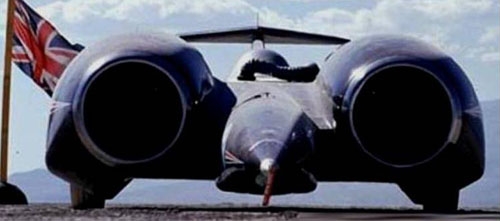
By Andy Green
BLOODHOUND, along with our competitors, is aiming to set a new Outright World Land Speed Record. In BLOODHOUND’s case, we’re aiming to push the Record past the astonishing target of 1000 mph. As you can see in the rest of this website, we’ve got some great technology, and some great sponsors, behind us and we’re confident that we can get there.
 However, none of our technical expertise will matter if we don’t meet the rules of the competition. The World Land Speed Record is regulated by the Fédération Internationale de l'Automobile, or FIA for short. The task of setting a record seems simple, as you just have to go faster than anyone else, ever. However, deciding what constitutes a ‘vehicle’, how you measure the speed, and so on, has caused some controversy in the past. To avoid any doubt about the validity of our Record, we will be following the FIA regulations very closely. The key rules are listed below as a ‘beginner’s guide’ and are taken from the FIA’s International Sporting Code, together with the Appendix D ‘Regulations for Land Speed Record Attempts’.
However, none of our technical expertise will matter if we don’t meet the rules of the competition. The World Land Speed Record is regulated by the Fédération Internationale de l'Automobile, or FIA for short. The task of setting a record seems simple, as you just have to go faster than anyone else, ever. However, deciding what constitutes a ‘vehicle’, how you measure the speed, and so on, has caused some controversy in the past. To avoid any doubt about the validity of our Record, we will be following the FIA regulations very closely. The key rules are listed below as a ‘beginner’s guide’ and are taken from the FIA’s International Sporting Code, together with the Appendix D ‘Regulations for Land Speed Record Attempts’.
Definitions
 Henry Ford, Lake St Clair, January 1904 – the only Outright Record ever set on ice
Henry Ford, Lake St Clair, January 1904 – the only Outright Record ever set on iceAll vehicles must meet the requirements of a ‘Land Vehicle’:
Vehicle propelled by its own means in constant contact with the ground (or ice), either directly by mechanical means or indirectly by ground effect, and the motive power and steering system of which are constantly and entirely controlled by a driver on board the vehicle.
From this definition, we can rule out an aircraft dragging its wheels along the ground through the measured mile (people do ask!), remote-controlled vehicles and computer assisted steering. As the driver, I’m expected to do all the work, which seems fair enough.
There are 3 kinds of Land Vehicles: Automobiles, which drive and steer through the wheels (i.e. conventional ‘cars’), ground effect vehicles (hovercraft), and Special Vehicles. BLOODHOUND (and all the other Outright Record contenders, for that matter) are Special Vehicles:
Vehicles on at least 4 wheels, which are propelled otherwise than through the wheels.
 Special Vehicle – Group C – Jet and Rocket
Special Vehicle – Group C – Jet and RocketThere are 4 Categories of World Record Vehicles, with Category A and B for Automobiles, Category D for Drag Cars, and the one that we’re interested in , Category C, for Special Vehicles which ‘may be sub-divided according to the type of engine used (jet, rocket, etc.)’. Obviously BLOODHOUND will have its own unique description as Special Vehicle – Category C – jet and rocket. For Category C, there is one other interesting addition:
The use of moveable aerodynamic devices is permitted.
Using a ‘moveable aerodynamic device’ is almost inevitable at Mach 1+, as I will be steering the Car using the supersonic airflow over the front wheels, with the grip from the surface having very little effect. This is less of a rule and more a statement of physics!
Record Requirements
The Record is the average of 2 passes through the measured mile (or kilometre) in opposite directions, a requirement first introduced in 1914 to reduce the number of people waiting around for a stiff following wind! To qualify for a record, BLOODHOUND will need to cover the distance twice within 60 minutes:
The duration of the attempt must not exceed one hour.
 ‘Normal servicing’ – Malcolm Campbell’s Bluebird, 1935
‘Normal servicing’ – Malcolm Campbell’s Bluebird, 1935That brings up the hugely demanding challenge of a turn-round within the 60-minute period. The Car will need to be prepared for the return run within about 45 minutes of rolling to a stop, so that we can get it started up again and back through the timing lights within the hour. The turn-round operations are defined as
All operations concerning refuelling, cleaning, tuning, fitting, replacement of wheels, tyres, sparking plugs, injectors, repairs and welding….. [with] tools, materials and equipment similar to that of a normal road service station….
Obviously, there is no such thing as a ‘normal road service station’ for a 1000 mph jet-and-rocket Car, but you get the general idea – this is meant to be a ‘normal’ servicing event. The BLOODHOUND team will need to load up about 3-400 kg of jet fuel and one tonne of High Test Peroxide (not at the same time – they don’t mix well!), remove the glowing-hot used rocket tube and replace it with a fresh fuel grain, replace the 100+ litres of (very hot) cooling water with fresh cold water, repack the drag chute, etc. It’s going to be a busy 60 minutes, but it’s all part of the challenge, so we’ve designed the rapid turn-round capability into the vehicle from the start.
Record Course and Timing
 Measuring the course for Thrust SSC, 1997
Measuring the course for Thrust SSC, 1997The timing must be conducted by an approved timekeeper from the national sporting authority, using FIA-approved timing equipment. BLOODHOUND is working with the South African Motorsports Association, as the FIA-approved national body in South Africa. The measured mile is the recognised distance for the Outright World Land Speed Record – both mile and kilometre times will be recorded, but it’s the mile speed that will appear in the record books. For these measured distances:
The length of the course must be measured to an approximation of 1/10,000th of its length.
For a measured mile, this is an accuracy of 16 cm or less. Sounds easy in the era of differential GPS and lasers, but until just a few years ago, this was a challenging task using steel measuring tapes and temperature-compensation tables.
For the timing:
Record time with an accuracy of 1/1000th of a second and calculate the mean time with an accuracy of 1/1000th of a second.
Calculate and record speed with an accuracy of 1/1000th of mph [for the mile] or kph [for the km].
Note that it’s the mean time of the 2 passes, from which they calculate the mean speed. Those with an eye for detail may have noticed that World Record speeds are not quite an exact average of the 2 individual speeds recorded in opposite directions. This is why. If you’re really bored, try and calculate the difference.
In addition:
The course will be of an open type with a maximum gradient of 1% over any 100 metre section..... In the case of a flying start, this gradient limit will apply to the whole run of the vehicle.
For Hakskeen Pan, this is not going to be a problem. Our survey data shows that the track only varies by about half a metre over the whole 20 km length.
I haven’t mentioned any requirement to beat the old record by 1%, because it’s been removed. Now you can beat it by as little as 1/1000th of a mph, and it still counts. Still, with BLOODHOUND aiming for 1000+ mph, I don’t think that’s going to be a problem for us.



